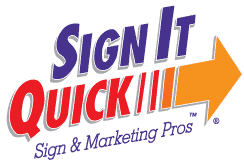Effective signage is a powerful marketing tool for businesses. It can attract customers, convey essential information, and reinforce brand identity. However, many businesses make common signage mistakes that can detract from their intended impact. In this article, we’ll explore three of the most prevalent signage errors made by businesses and provide guidance on how to avoid them.
Lack of Clarity and Simplicity
One of the most fundamental and widespread signage mistakes is a lack of clarity and simplicity. Signs should communicate their messages quickly and effectively, but many businesses clutter their signage with excessive information, complex graphics, or distracting design elements.
The Problem:
- Overcrowded Signage: When a sign tries to convey too much information, it becomes overwhelming and difficult to read. Customers may ignore the message entirely because they don’t have the time or patience to decipher it.
- Complex Graphics and Fonts: Elaborate graphics, fonts, or color schemes can make signage difficult to understand, especially from a distance. Customers may struggle to discern the intended message or simply move on without giving the sign a second thought.
How to Avoid It:
- Prioritize Key Information: Identify the essential message you want to convey with your signage. Whether it’s your business name, a promotional offer, or directional information, ensure that the most critical content stands out.
- Use Legible Fonts: Select easy-to-read fonts and maintain a font size that is appropriate for the distance at which your sign will be viewed. Clarity should always take precedence over fancy design elements.
- Keep it Simple: Avoid excessive detail, intricate patterns, or excessive text. A simple, uncluttered design is more likely to be effective in capturing attention and conveying your message.
Poor Visibility and Location Choices
Ineffective signage placement can render even the most well-designed signs ineffective. Choosing the wrong location or failing to consider visibility factors can significantly impact a sign’s success.
The Problem:
- Hidden or Obscured Signs: Signs that are obscured by other objects, structures, or even competing signs are often ineffective. If customers can’t see your sign, they won’t know your business is there.
- Poor Lighting: Inadequate or incorrect lighting can make your signs difficult to read, especially at night. Dimly lit signs can deter potential customers or lead to missed opportunities.
How to Avoid It:
- Strategic Placement: Consider the placement of your signage from the perspective of your target audience. Ensure that it’s visible from high-traffic areas and, if necessary, choose complementary signage locations to maximize visibility.
- Lighting Considerations: Evaluate the lighting conditions in the area where your signage is located. Install proper lighting, such as spotlights or LED illumination, to ensure your signs are visible day and night.
Neglecting Consistent Branding
Inconsistent branding is a pervasive mistake that can dilute your brand identity and make your signage less impactful. Your signs are a direct reflection of your business, and inconsistent branding can confuse customers and erode trust.
The Problem:
- Inconsistent Design Elements: Using different fonts, color schemes, or logos across various signs and marketing materials can lead to brand inconsistency. Customers may not immediately recognize your business or may question your professionalism.
- Mismatched Signage: Signs that don’t align with your overall brand identity can create a discordant customer experience. If, for example, your signage differs drastically from your website or promotional materials, it can confuse and deter customers.
How to Avoid It:
- Create Brand Guidelines: Establish comprehensive brand guidelines that specify acceptable fonts, color schemes, logo usage, and design elements. Share these guidelines with your design and marketing teams, ensuring that all your signage adheres to a consistent brand identity.
- Regular Auditing: Periodically review your signage and marketing materials to ensure they align with your brand guidelines. This ongoing maintenance will help you catch inconsistencies and make necessary updates.
- Professional Consultation: If you’re unsure about how to maintain brand consistency, consider consulting a professional designer or branding expert. They can offer guidance on ensuring all your signage is in harmony with your brand.
Conclusion
Effective signage is a vital component of your business’s marketing and customer engagement efforts. By avoiding common signage mistakes, you can ensure that your signs effectively convey your message, attract customers, and reinforce your brand identity. Clarity and simplicity, thoughtful placement and visibility, and consistent branding are essential aspects to consider when creating signage that truly makes an impact. Remember that successful signage is not just a matter of aesthetics; it’s a strategic tool that can help your business thrive and stand out in a competitive marketplace. Contact us for a quote today!




0 Comments